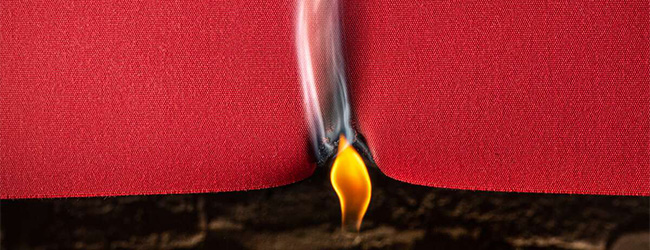Fire safety is paramount in countless settings, from homes and workplaces to outdoor and industrial environments. As such, fire-retardant materials and flame-resistant fabrics play a critical role in protecting people and properties by offering much-needed protection in the event of a fire.
Flame-Retardant Fabrics
Fire-retardant fabrics (FR fabrics) are engineered to slow down or suppress the spread of flames when the material is exposed to a fire source. This method offers a level of fire protection to fabrics that would otherwise burn quickly. Flame-retardant fabrics are often treated with a surface coating and are not inherently resistant to fire.
Standards and Certifications: Common standards for these types of materials include NFPA 701 (National Fire Protection Association) and ASTM (American Society for Testing and Materials). These standards are designed to evaluate fabric ignition resistance, flame spread, and charring behavior.
There are quite a few common uses for flame retardant materials in personal, residential, and commercial settings. They include, but aren’t limited to:
- Upholstery: Furniture in homes, hotels, and public spaces can benefit greatly from flame-retardant fabrics for added safety.
- Drapery: Curtains and drapes can be treated with flame-retardant chemicals to reduce fire risk.
- Tents and Recreational Fabrics: Camping tents and outdoor fabrics may be flame-retardant to enhance safety around campfires.
- Clothes: Flame-retardant clothing can be lifesaving for first responders and individuals who work in flammable environments.
Flame-Resistant Fabrics
Flame-resistant fabrics are made from fibers that have inherently fire-resistant properties. Unlike flame-retardant fabrics, their fire resistance is permanently baked into the fiber structure. Trivantage offers dozens of inherently FR fabrics for countless application opportunities.
Standards and Certifications: Flame-resistant fabrics will often require CA State Fire Marshal Title 19 certification while also adhering to NFPA 701 and ASTM standards. Some fabrics may meet specific industry certifications based on how they’re used.
You can find fire-resistant fabrics used in many applications that require long-term durability and fire resistance. Some of the most frequent applications include, but are not restricted to:
- Awning & Shade Fabric: Commercial buildings, schools, hospitals, healthcare facilities, government buildings, and apartment buildings are just some of the most common places FR fabric may be desired, if not legally required.
- Shade Sail Fabric: These kinds of permanent outdoor structures can greatly benefit from the extended fire protection provided by flame-resistant fabrics. This is especially important in extremely hot or dry environments with constant exposure to the elements.
- Marine Fabrics: Often seen on cruise ships and large capacity passenger vessels, IMO-certified marine textiles may be flame-resistant. This adds another layer of protection and peace-of-mind while on the water, after mooring, and even in storage for the winter.
Differences Between Flame-Retardant and Flame-Resistant Fabrics
Although the names are similar and often used interchangeably, there are a few key distinctions between flame-retardant and flame-resistant fabrics. They include:
- Resistance Source: Flame-retardant fabrics technically gain their fire-resistant properties through chemical treatments. On the other hand, flame-resistant fabrics are naturally resistant because of the composition of their material.
- Durability: Flame-retardant surface treatments can sometimes diminish in quality and effectiveness over time after being washed or exposed to the elements. Flame-resistant fabrics maintain their resistance throughout the lifespan of the material.
Choosing the Right Type of Fabric
Selecting the ideal flame-retardant or flame-resistant fabric requires careful consideration of several factors. They include, but aren’t limited to:
Environment and Application
- Indoor Residential: Flame-retardant fabrics can be used for furniture upholstery, drapery, and other indoor textiles, helping to save lives and property especially in fire-prone regions.
- Outdoor: Think about the level of UV exposure, moisture, and the potential wear and tear your fabrics may encounter. In many cases, flame-resistant fabrics can be excellent for awnings and outdoor furniture fabrics.
- Industrial or High-Risk: Environments with open flames, sparks, or extreme heat require specialized flame-resistant protective clothing and materials. Fabrics like Nomex, Kevlar, and other fire-resistant textiles are excellent for these applications.
Required Level of Protection
Flame-retardant materials can help delay the spread of fire while providing extra time to evacuate or fight the flames. On the other hand, flame-resistant fabrics are designed to self-extinguish when the source of the fire is removed. This can help prevent the fire from spreading.
It's important to note that no fabric is entirely fireproof. However, certain flame-resistant materials can stand up to extremely high temperatures for a long period of time offering critical protection.
Durability Requirements
Due to their fire-resistant fibers, flame-resistant textiles are often the preferred choice for scenarios requiring long-lasting fire protection.
It’s important to remember that flame-retardant treatments lose their effectiveness due to washing, wear, or environmental exposure. This is why it is important to consider the feasibility of reapplying flame-retardant spray or treatment.
Standards and Regulations
- Industry-Specific: In certain industries, specific fire-safety regulations and standards (NFPA 701, ASTM, etc.) may apply. Ensure your fabric selection aligns with the relevant requirements.
- Public or Commercial Spaces: Public buildings usually have strict fire codes. Ensure your fabric aligns with local regulations.
See the Fabric Selection at Trivantage
At Trivantage, we understand the importance of fire safety for individuals, businesses, and destinations. Our extensive collection of flame-retardant and flame-resistant fabrics is perfect for various applications, including outdoor spaces, marine settings, and DIY flame-resistant clothing.
Get in touch with our knowledgeable team today to discuss which fire-resistant or retardant fabrics best suit your project’s needs.





